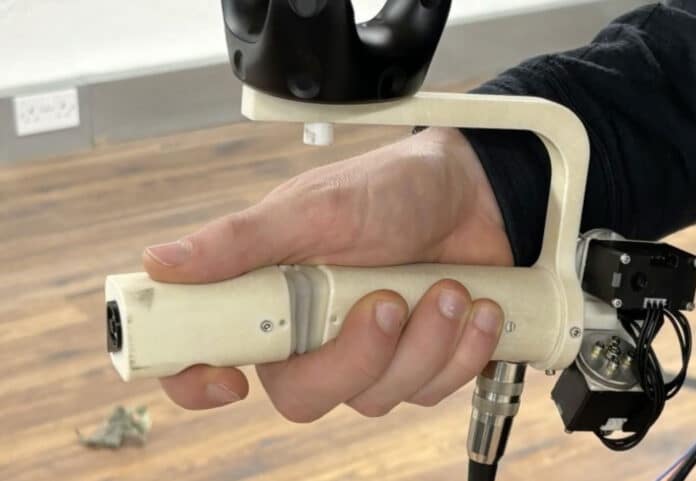
By Ashwini Sakharkar 10 Dec, 2024
Collected at: https://www.techexplorist.com/shape-device-helps-people-visual-impairment-perform-navigation-task/94382/
Researchers at Imperial College London, in collaboration with MakeSense Technology and the charity Bravo Victor, have created a shape-shifting device named Shape, designed to empower people with visual impairments to navigate effectively through haptic perception. Shaped like a torch, this device flexes to guide users in the right direction and straightens when they are correctly oriented.
The study demonstrated how well individuals with visual impairments were able to locate targets in a 3D virtual reality environment using Shape and vibration feedback technology, commonly employed for navigation assistance. The study also included sighted participants, enabling direct comparison of navigation abilities.
“The exciting thing about this study is we’ve managed to demonstrate that Shape can help people with visual impairment perform a navigation task as well as sighted people. This is something that we haven’t seen before with other navigation devices,” said Dr Ad Spiers, lead researcher for the study, from Imperial’s Department of Electrical and Electronic Engineering.
“Shape is unusual because it uses our ability to understand information through touch in a way that goes beyond vibration. Humans have an innate ability to feel and interpret shapes through our hands, with very little concentration. Exploiting this allows us to create a device that is simple to learn and isn’t tiring to use.”
The study compared the performance of 10 participants with visual impairment to that of 10 sighted individuals, focusing on their ability to locate targets as quickly as possible in a controlled indoor environment. It measured the time taken to locate virtual targets and assessed the efficiency in locating these targets.
The findings revealed no significant performance gap between visually impaired users of the innovative Shape device and their sighted counterparts relying purely on natural vision. More impressively, participants with visual impairments were able to locate targets significantly faster-using Shape compared to traditional vibration technology.
User feedback indicated that participants with visual impairment preferred using Shape over vibration technology. The researchers are optimistic that this device, considered to be the most advanced of its kind, could represent the future of navigation technology for individuals with visual impairment. The Shape device offers significant benefits over existing tools used to assist people with visual impairments.
“The impressive results from this study demonstrate the enormous potential of this technology to make life-changing improvements in mobility for people with visual impairment,” said Dr Robert Quinn, CEO of MakeSense Technology. “Building upon the research described in this paper, MakeSense is developing a blind wayfinding product that leverages the latest advancements in spatial artificial intelligence and computer vision without the need for interpretive training. We are aiming for our first product to be available from the end of 2025.”
At present, people with visual impairments typically rely on aids like white canes or guide dogs. Although guide dogs can be quite effective, they necessitate costly professional training and can incur annual expenses, reaching thousands of pounds.
White canes assist in navigation by indicating where not to go, thereby restricting the user’s ability to navigate effectively in intricate environments.
Recent technological advancements have primarily centered around the use of auditory interfaces, which provide audio instructions such as “turn left at the next corner” or vibration feedback that conveys movement direction through specific vibration patterns.
However, auditory cues can obstruct users from hearing important sounds around them, which may put them at risk of hazards. Also, vibration feedback can cause numbness after prolonged use, leading to frustration and distraction for users who find constant vibrations irritating.
To effectively evaluate the performance of the Shape device against vibration technology and natural sight, researchers meticulously designed a simulation that closely mirrors real-world navigation while minimizing variations between experiments. In genuine navigation scenarios, variability is expected due to fluctuating weather conditions and the presence of pedestrians or obstacles.
Moreover, real-world environments often present numerous potential targets, unlike the single targets examined individually in this controlled study. It is essential to conduct further research to fully understand how the Shape device performs in these dynamic real-world situations.
Developed in partnership with MakeSense Technology, a startup co-founded by Dr. Robert Quinn—an accomplished Imperial PhD graduate in Mechanical Engineering—the Shape device benefits from a foundation grounded in innovation.
With the support of Imperial’s thriving entrepreneurial ecosystem, which seeks to foster transformative solutions, MakeSense is poised for success. Following the Shape study, MakeSense is now working to improve the technology for effective outdoor navigation. It is hoped that the device will be ready for practical use in real-world environments in the coming years.
Journal reference:
- Robert Quinn, Stephen Murtough, Henry de Winton, Brandon Ellis-Frew, Sebastiano Zane, Jonathan De Sousa, Theofilos Kempapidis, Renata S. M. Gomes & Adam J. Spiers. A shape-changing haptic navigation interface for vision impairment. Scientific Reports, 2024; DOI: 10.1038/s41598-024-79845-7

Leave a Reply